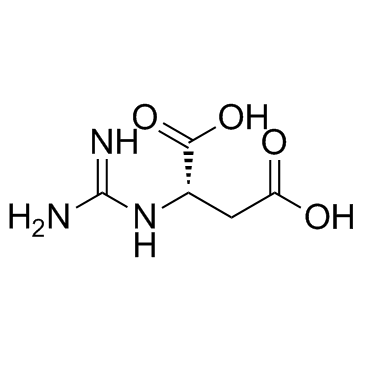Guanidinosuccinic acid (Synonyms: Guanidinosuccinic Acid, NSC 49078) |
| Catalog No.GC31413 |
El Ácido guanidinosuccÍnico es un metabolito nitrogenado.
Products are for research use only. Not for human use. We do not sell to patients.

Cas No.: 6133-30-8
Sample solution is provided at 25 µL, 10mM.
Guanidinosuccinic acid is a nitrogenous metabolite isolated in excess from serum and urine.
Guanidinosuccinic acid, a constituent of normal urine, is elevated in the urine and serum of azotemic patients[1]. Guanidinosuccinic acid (GSA), a guanidino compound found to be greatly increased in uremia, is administered by intraperitoneal (i.p.) injection to adult albino mice and to young mice 7, 14 and 21 days old. Epileptogenic and toxic properties are assessed and Guanidinosuccinic acid brain levels following i.p. injection ae determined. In adult mice, Guanidinosuccinic acid induces long-lasting generalized clonic and clonic-tonic convulsions in a dose-dependent manner with a CD50 (and 95% confidence interval) of 363 (287-458) mg/kg (n=35), and an LD50 of 579 (445-756) mg/kg. The CD50 of Guanidinosuccinic acid corresponded with a brain concentration of 56 nmol/g tissue. Electrocorticographic recording in five adult mice revealed epileptiform discharges (spikes, spike-waves, and polyspike-waves) which appeared concomitant with the convulsions, When young mice are i.p. injected with a (for adults) subconvulsive dose of Guanidinosuccinic acid (250 mg/kg), an age-dependent decrease is noted in Guanidinosuccinic acid-induced convulsions and in the resulting brain concentration[2].
[1]. Milstien S, et al. Role of intestinal microflora in the metabolism of guanidinosuccinic acid. J Bacteriol. 1973 May;114(2):641-4. [2]. D'Hooge R, et al. Behavioral toxicity of guanidinosuccinic acid in adult and young mice. Toxicol Lett. 1992 Dec;64-65 Spec No:773-7.
Average Rating: 5 (Based on Reviews and 30 reference(s) in Google Scholar.)
GLPBIO products are for RESEARCH USE ONLY. Please make sure your review or question is research based.
Required fields are marked with *




















